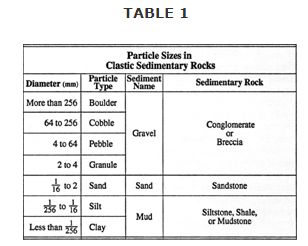Clastic Sedimentary Rocks
Clastic sedimentary rocks are classified according to the grain size of the sediment and the kinds of rock fragments that make up the sediment (Table
). Grain size is largely a function of the distance the particle was transported. In general, the greater the distance traveled, the smaller and more rounded the sediment particles will be. This smoothing of rock fragments during transportation is called
rounding.

Large, coarse, angular pieces of sediment will be deposited near the source area; well‐rounded sand grains will have been transported a considerable distance before being deposited; silt, mud, and clay have been carried even farther. This process is called sorting.
Coarse‐grained rocks. Sedimentary breccia contains an abundance of coarse, angular fragments of gravel that were deposited very near the source area. A conglomerate is formed from coarse‐grained, rounded pieces of gravel. Sandstone is a medium‐grained rock that contains rock particles (mostly quartz) about the size of sand. The grains in a quartz sandstone are at least 90 percent quartz. Graywacke is a type of “dirty” sandstone that consists of more than 15 percent silt‐sized or clay‐sized (finer‐grained) material that imparts a darker or speckled appearance. If a coarse‐grained sandstone consists of over 25 percent feldspar grains it is called an arkose.
Finer‐grained rocks. The finer‐grained clastic sedimentary rocks are called shale, siltstone, and mudstone. Shale is a smooth, thinly layered rock that is made up of fine‐grained silt and clay particles. Shale is considered a fissile rock because it splits very naturally along its layers. A siltstone contains mostly silt grains and looks very similar to shale but is not as fissile. Mudstone, the finest‐grained clastic rock, is not well layered, and contains more clay than does shale or siltstone. Most shales, siltstones, and mudstones are tan, brown, gray, or black.